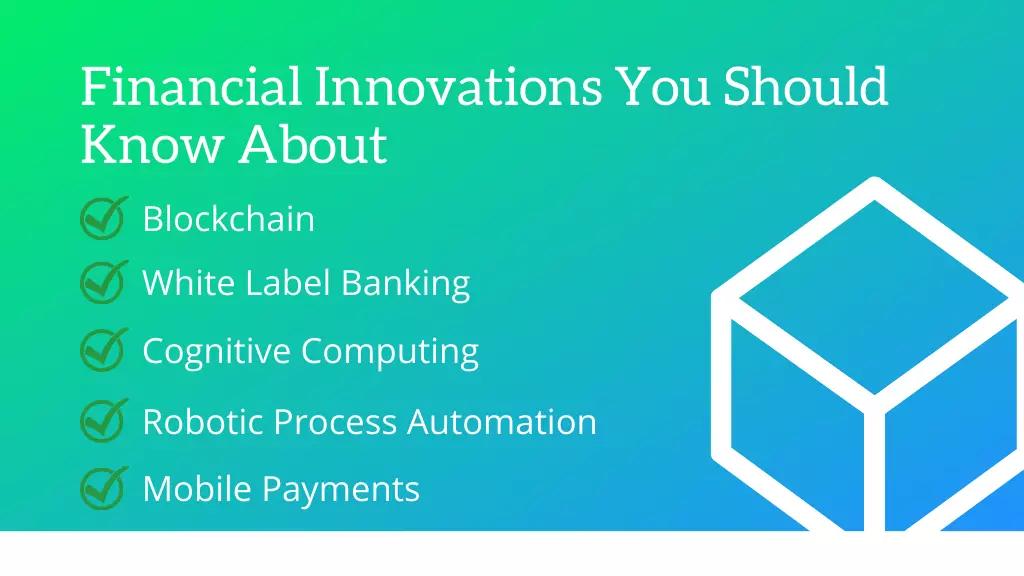Thanks to the penetration of technology, the way we manage our money has witnessed a landmark change over the past few years.
New financial innovations allow financial institutions worldwide to provide customers with novel and exciting ways to use and handle their money.
What is financial innovation?
Financial innovation includes new financial instruments in the financial market and institutions through new technology. It’s no longer a buzzword and has become an integral part of the finance sector.
Financial institutes can reduce risk management when making lending decisions and offer customers data-backed advice on making investments through financial innovations. It also improves the financial products and instruments that may be beneficial for consumers and businesses alike.
Read: How to convert art to NFT?

When mobile banking was nascent, no one ever thought of the rippling effects it’s likely to bring in the financial world. But, today, we all are so accustomed to using mobile banking that we want all banking-related transactions at the tip of their fingers.
That’s how financial innovation is bringing a paradigm shift to create a better financial world for everyone.
In this article, we discover some cutting-edge financial innovations that impact the world and make the future bright from this financial sector.
5 Financial Innovations and What They Mean to the World
Here are five financial innovations disrupting the financial world and will continue to do so in the coming years.
1. Blockchain
Since the notable rise of cryptocurrency, blockchain is touted as the next big thing. Financial institutions are more than ready to exploit the potential of blockchain. Companies worldwide are leaving no stone unturned to use this disruptive technology to provide financial services that can bring down the overall cost of financial services for your customers.
Blockchain is a ledger of recorded financial transactions. You can publish and distribute this ledger at multiple locations, and every time a transaction takes place, a ledger is added to each copy.
Using blockchain, businesses can enable open and secure business networks that ensure efficient processes, new financial services, and reduced costs.
From supporting cross-border transactions to providing a trade finance platform, blockchain makes many financial processes faster, accurate, and less expensive.
It enables issuing of digital securities in a short period, at a low cost, and with greater customization.
Also, with blockchain boasting of a recording capability, this technology is likely to make current clearing and settling procedures of a bank redundant, thereby resulting in much faster transactions and reduced costs for financial institutions.
Also, banks worldwide are using blockchain-enabled IDs to identify customers and their information. This is helping banks protect customers against fraud and speed up the customer verification process.
Platforms supporting blockchain financial innovation: Platforms like MoonPay works as a global payment solution that supports cryptocurrency. It powers wallets, apps, and websites and allows a customer to make instant bank transfers. With this platform, you can buy and sell cryptocurrency and USD Coins in more than 160 countries.
2. White label banking
White labeling allows a company with no banking license or regulatory infrastructure to provide financial products to its customers. In this white labeling, banking companies take third-party manufactured financial products and use their label and market the product under their label.
In other words, a white label bank is banking as a service (BaaS) provider that uses a bank’s API to build its financial products over a licensed bank’s infrastructure.
White labeling allows a brand to give complete control over customer experience, explore new financial products, and control production, planning, pricing, and profits.
Read: How You Can Achieve Full CECL Compliance Today?
The BaaS stack involves three-layered technology and primarily involves three players, namely fintech, regulated banks, and brands. Regulated banks are the foundation of a BaaS solution that provides a banking license and handles all legal formalities.
On the other hand, fintech operates as the middle-layered stack and provides all desired services and solutions. Brands occupy the top layer and are responsible for controlling branding and customer experience.
BaaS is slowly gaining traction and will likely make the banking process much easier and smoother for customers.
Platforms supporting white label banking: Chime is an excellent finance management tool supporting white label banking.
3. Cognitive computing
More than any industry, cognitive computing is increasingly adapting to digital technologies.
While AI provides organizations with unprecedented efficiency and automation, another technology fueling financial innovation is cognitive computing.
Cognitive computing is a process that helps machines the ability to think and behave like humans. In other words, cognitive computing is AI with a significantly higher level of complex problem-solving ability and high-level analysis.
Today, customers face robots and deal with AI machines for money withdrawal, bank statement printing, and funds transfer.
From contextualized customer service through chatbots on business websites to improving the security systems, cognitive computing is bringing a much-required revolutionary change in the banking and financial system.
Read: Core Banking Software Development Journey
Interestingly, this disruptive technology can analyze customer behavior, mode of transaction, average monthly spending, and beneficiaries. This can help security systems understand whether a transaction is legitimate or not.
Based on the probability of cyber attacks, the banking system can introduce another layer of security to prevent hackers from gaining access to customers’ personal information.
Financial innovation like cognitive computing is ready to introduce technological innovations like never before.
Platforms that support cognitive computing: Platforms like TCS provide financial institutions with a cognitive analytic engine that improves the efficiency of financial audits.
4. Robotic process automation (RPA)
RPA is an exciting technology, and industrial manufacturing companies widely use RPA to assemble cars and even small plastic parts. However, this technology is slowly gaining traction in financial processes and accounting practices.
From auditing financial statements to speeding up the compliance process to automating unstructured data from emails, documents, and forms, RPA is helping bring a financial revolution.
Accounting companies are widely using RPA to minimize errors and prevent employees from entering data manually.
While it’s quasi-impossible to avoid data entry errors in accounting, RPA can extract information from forms and speed up all your accounting processes while ensuring compliance. Also, RPA is useful in conducting internal audits.
Robots can compare various tasks that are necessary for general revenue audits. This ensures that employees don’t perform tedious tasks and can focus on producing detailed auditing reports.
Also, as RPA is rule-based, it’s excellent for detecting if there occurs a potential violation of business parameters.
Read: The Development Cost and Features of Cannabis Delivery App
RPA can be your go-to factor for bringing a much-required change in your financial institution.
Platforms supporting RPA: Capgemini offers a nine-pillar approach to RPA for the financial
sector. It helps lower business costs and achieves regulatory compliance.
5. Mobile payments
For quite some time, mobile payments have been at the top of the financial innovation value pyramid. With people confined to their homes due to month-long lockdowns and pandemic, it was the mobile payment that made things easier for everyone.
While mobile payments have drastically reduced the time and cost to make online payments, it’s still in its exploration stage.
With biometric payments slowly paving the wave and augmented reality revolutionizing digital payments, there will likely be a surge in several mobile payments and mobile wallet users. The proliferation of Neobanks will bring another revolutionary change.
Neobanks are digital banks that enable customers to do a range of banking activities on their mobile phones. These Neobanks are slowly gaining traction in countries that already have regulations for governing such digital banks.
But, wait!
The innovation is not yet over. There is still a massive market for inter-currency payments that can further revolutionize the banking landscape.
Read: How Technology Can Help Us in Healthcare?
The future of mobile payments will witness continuous and relentless growth, and its use is likely to explode in the coming years.
Platforms supporting mobile payments: Apple Pay is a great mobile payment platform that allows users to make transactions at the tip of their fingers.
Wrapping up
Financial innovation drives growth across every sector because financial economics leaves a lasting impact on consumers and businesses. Also, financial innovations play a crucial role in financial modernization, leading to economic well-being.
But, the right innovation is one that meets the needs of your customers and helps solve a business problem. Companies that focus on innovation primarily find success because they hit the market with the right product at the right time.
For creating financial innovation, companies need to focus on customers’ requirements and conduct thorough research to identify the financial gaps.
Read: Comparison of Project Management Methodologies
Mobile payments will become a ravage in the coming years owing to the rapid adoption of digital technology. While blockchain has a brighter path ahead, it's success depends on a business's ability to overcome any blockchain-related challenge.
The future of finance looks extremely promising. The rise of new technologies like AI, cognitive computing, blockchain, and RPA enables greater scope and can help businesses serve their customers efficiently.
In the coming years, technology will likely make financial services and products more secure for customers and profitable for a business.

